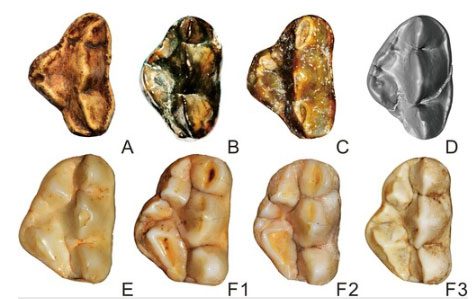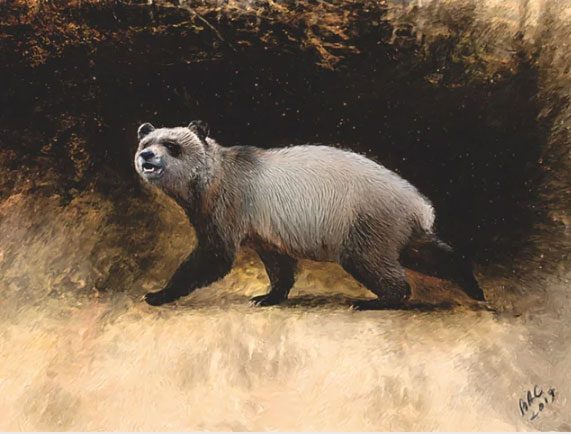Surely, each of us has heard the name ‘panda’ at least once – a cute animal regarded as the “national treasure” of China. In the past, pandas roamed throughout Asia and Europe.
The Mysterious Panda Teeth in Bulgaria
The giant panda (scientific name: Ailuropoda melanoleuca, meaning: “black and white cat-footed animal”) is a bear species native to China. It is easily recognizable by its large black patches around the eyes, on the ears, and its limbs. Although classified under the order Carnivora (meat-eating mammals), the panda’s diet consists of over 99% bamboo.

Although classified as a carnivore, the panda’s diet consists of over 99% bamboo. (Image: NatGeo)
In ancient times, pandas were considered rare and strange creatures, nicknamed “monsters.” They were described in folklore as beasts that ate iron, leopards, and scorpions. In the work “Records of the Grand Historian: The Year of Emperor Ban Ji”, it was recorded that pandas were used in battles. This indicates that pandas were not as gentle and cute as they appear.
Pandas are typically found in the mountain ranges of Sichuan and Shaanxi, China. Although pandas are regarded as endemic to China, few know that, in the past, they roamed across Asia and even into Europe. Scientists have found evidence of panda relatives in Hungary, Spain, and Bulgaria.

Fossilized teeth discovered in Bulgaria. (Image: NatGeo)
This fact was “discovered” in the late 1970s. A worker at a coal mine in Northwestern Bulgaria accidentally found two fossilized teeth. He later brought them to the National Museum of Natural History for expert assessment. Unfortunately, these teeth were forgotten for decades.
It wasn’t until Nikolai Spassov, a paleontologist working at the same site left by Nikolov after retirement, decided to have the teeth examined. Spassov noted that these teeth belonged to an animal that died at least 5-7 million years ago, during the Messinian geological period.

The similarities between the fossilized teeth found in Bulgaria and the teeth of modern pandas. (Image: NatGeo)
Suspecting that the deceased animal was a bear, Spassov compared it with fossils of brown bears found in the area. The results were unexpected; he found no significant match between the two specimens.
Surprisingly, during a chance encounter with samples of giant panda teeth, Spassov realized how similar they were to the samples he was studying. He revisited the records to confirm that these must be panda teeth.

A complete image of the ancient panda in Europe reconstructed from the found fossils. (Image: NatGeo)
From the fossils discovered, archaeologists reconstructed their skeletal structure and created a complete image of the panda species in Europe. However, after experiencing a climatic event known as the Messinian Salinity Crisis at the end of the Miocene, sea levels dropped by 70 meters. Consequently, freshwater lakes evaporated, leading to the extinction of numerous plant and animal species dependent on them, including the European panda. As a result, only the pandas in China survived to this day.
The Journey to Becoming China’s National Treasure

Pandas are a national treasure of China. (Image: NatGeo).
The designation of pandas as a national treasure was entirely due to a foreigner – Father Armand David. In 1862, Father David discovered a “very special black and white bear skin” in China. He believed that pandas “would become a very interesting new species.”
At that time, China did not prioritize or protect pandas, and David, who cherished these animals, sought to find ways to remove them from China. Since then, a love for pandas developed among foreigners, leading countries to send representatives to China in search of them. This was a primary reason for the dramatic decline in the giant panda population, as at least 200 living pandas were sent abroad during this period, with many dying during transport.

Due to excessive hunting, pandas were nearly extinct. (Image: NatGeo)
It wasn’t until the 1940s that China recognized the severity of the issue, prompting the government to actively conserve pandas. In 1988, China officially designated pandas as a class 1 protected species. This was also the moment pandas officially became “national treasures” of China after decades of facing existential threats from hunting.

Today, pandas are considered a precious gift that China offers to many nations. (Image: NatGeo)
Since then, pandas have been viewed as an invaluable gift, referred to as “panda diplomacy.” China has gifted pandas as diplomatic gifts to many countries, including Russia, North Korea, the United States, the United Kingdom, France, Germany, and Japan…




















































